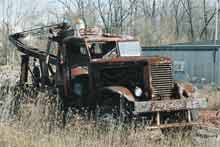John Katz passes this Reo tow truck each time he returns home from Baltimore. It sits beside the northbound lane of I-83 between York and Harrisburg, Pennsylvania. Athough it will take centuries for it to rust to dust – Reo, after all, was the “World’s Toughest Truck,” according to its manufacturer – John would like to see it better loved. That doesn’t mean, however, that he’s likely to take it home.
Reo was, of course, Ransom E. Olds’s second automotive venture. Leaving his Oldsmobile, and his name, behind, he applied his initials to a new firm, the Reo Motor Car Company, in 1904. His Reo cars sold well – third place in 1907 and almost always in the top ten – and were joined by a line of commercial cars in 1906. A subsidiary, Reo Motor Truck Company, was formed in 1910. Despite coining the name “Speed Wagon” in 1915, Reo trucks were pretty conventional, upright and stodgy right through to
1929.
Reo ceased car manufacture in 1936 to concentrate on trucks. The truck designs became more stylish, following the fashions of the day, and Reo supplied a line of rebadged light trucks to Mack, to be sold as
Mack Jr. Further restyling for
1938 portended that Reo would become a trendsetter.
Emerging from bankruptcy in 1940, Reo didn’t exactly start a trend, but the trucks made their mark. Called “Moreload,” for their cab-forward design, they were like nothing else on the market. The bold front end leapt forward, its front axle pushed back. Reos were built in sizes from 1-1/2 ton capacity up to 68,000 pounds GVW, and offered a choice of gasoline or diesel engines. A few
pickups were built, big he-man pickups, not the half-ton type they had supplied to Mack. My home town road department used Reo
dump trucks and my high school had a
Reo bus.
In 1950, the Reo prow was
squared off a bit, and in 1954 a V8 engine was offered, built in-house, as all its gasoline engines had been. Front end design was
blunted still further in 1955.
In 1954, Reo Motors, as the company had become in 1940, was acquired by Bohn Aluminum and Brass Corporation. If Reo in the 1930s and ’40s had been poor, it now became a stepchild. By 1957, White Motor Company owned Reo, and the following year bought Diamond T. What followed was a line of Diamond Reo trucks aimed at the top of the truck market. They had trouble staying there. Diamond Reo Trucks, Inc. was sold in 1971, and went bankrupt four years later. Loyal Osterlund, a D-R dealer, bought the rights and tooling, and he and successive owners struggled on through the late 1990s. Diamond Reo finally petered out in 2001. Ironically, it is the Diamond Reos that are best remembered by today’s youth, along with REO Speedwagon, the band.
That leaves us with the task of identifying the
Reo spotted by John Katz. It doesn’t appear in the
spotter’s guides, but Reo authorities Bob Ebert and Jim Neal figured it out. What John saw is a
World War II Reo 6×6 wrecker, of a style built for the U.S. Army. Bob and Jim have, with Tim Fijalkovich, written a book, The World’s Toughest Truck: The Reo/Diamond Reo Story, to be published by Driveline Publications, a subsidiary of Antique Power, Inc. It should be out later this year. Until then, Reo restorers will find kinship in the Reo Club of America.

